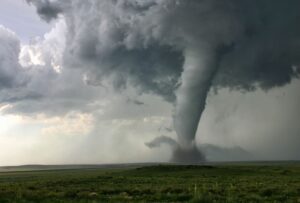The Golden Years are not so shiny in these times of climate crisis. But while older adults are especially vulnerable to some of the worst impacts of climate change, we also are among those who have the knowledge, resources, and motivation to help turn the tide. Climate change impacts all of us by threatening our access to a safe livable world with clean air, water, food, and adequate housing. But as a “vulnerable population,” older adults are particularly prone to the impacts of climate change.

Tornado
Climate disasters are acute events such as extreme storms, flooding, and wildfires. Each of these disasters are particularly threatening to older adults. Due to a variety of factors, older adults’ ability to flee to safe areas and protect themselves from injuries during disasters may be compromised or dependent on others for assistance and rescue.
Other concerns that make climate disasters especially difficult for some older adults include the fact that temporary shelters can be overwhelming, crowded, and located in unfamiliar open public places. Chaotic environments can be disorienting and confusing, especially for those with pre-existing cognitive difficulties. This can tip the balance for those marginally coping and create cycles of physical and mental health decline.
Also, loss of treasured family memorabilia can be particularly distressing to older adults, further disconnecting them from the everyday items that help provide solace and keep them oriented and connected to their loved ones through memories.
Extreme temperatures are the deadliest weather-related event, with an estimated 12,000 Americans dying every year due to heat waves. Adults over 60 are estimated to account for 80% of these heat-related deaths.
Older people are especially vulnerable since their capacity for maintaining core body temperature becomes more compromised with age. Heat and dehydration are physically stressful for people with chronic medical conditions. Declining ability of cardio-vascular efficiency to shift blood to the skin contributes to less efficient sweating, the body’s primary defense against overheating. Also, medications used for chronic illnesses add risk to the ability to maintain cool body temperatures.
Poverty and race also contribute to vulnerability. Inner cities with crowded substandard housing, higher temperatures due to urban heat island effect, and lack of air-conditioners all are “multipliers” of risk in poor neighborhoods where people of color live.
Checking in on isolated older adults can be a powerful and simple way to assist family members and neighbors in surviving heat extremes. And guides for surviving extreme heat, including those prepared by the Climate Psychiatry Alliance, can help older adults prepare for these inevitable periods and are available for distribution.
Although older adults are more vulnerable to the impacts of climate change, planning ahead help can prevent some of the most severe outcomes.
For example, to help protect yourself and your loved ones from exposure to air pollution: 1) Stay informed about local air quality through receiving air quality alerts on phones, following local news, or checking air quality at airnow.gov., 2) When air quality is low, stay indoors if you can with windows closed, using portable air filtration devices. Having adequate supplies of medications and food will minimize the need to go out. 3) If trips outdoors are necessary during bad air-quality days, using an N95 face mask can be protective, & 4) Increased air pollution often happens during extreme heat periods. And remaining in hot rooms at home without the ability to open windows for cooling ups your health risk. Have a plan in place to be able to get to your local cooling centers, which are located at government-run senior centers, community centers, parks and recreation sites and public buildings like libraries. Article courtesy of National Council on Aging
